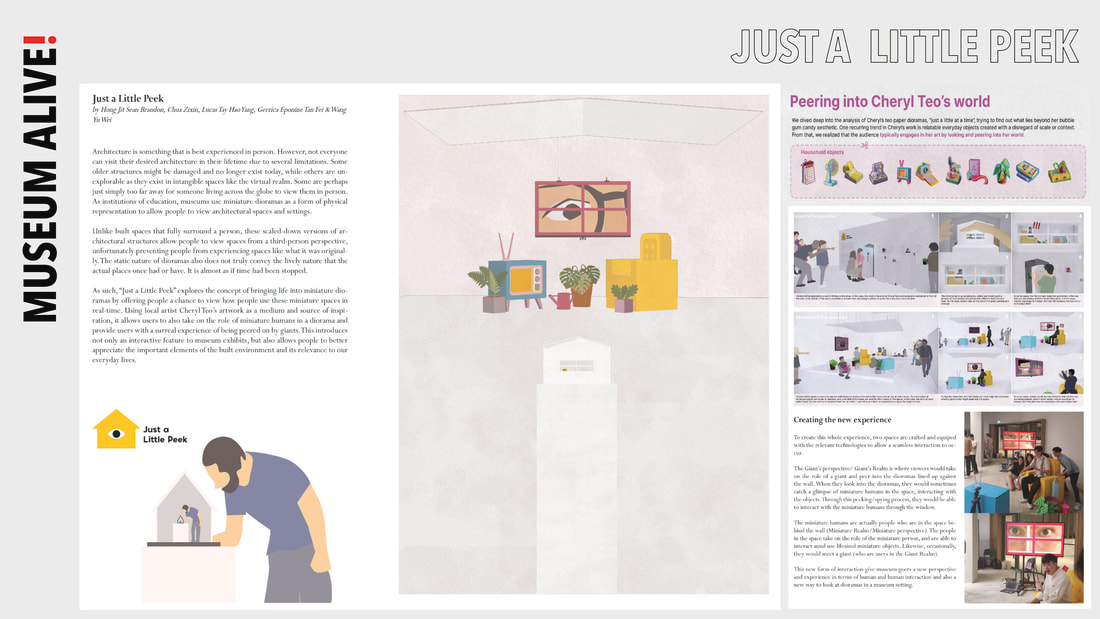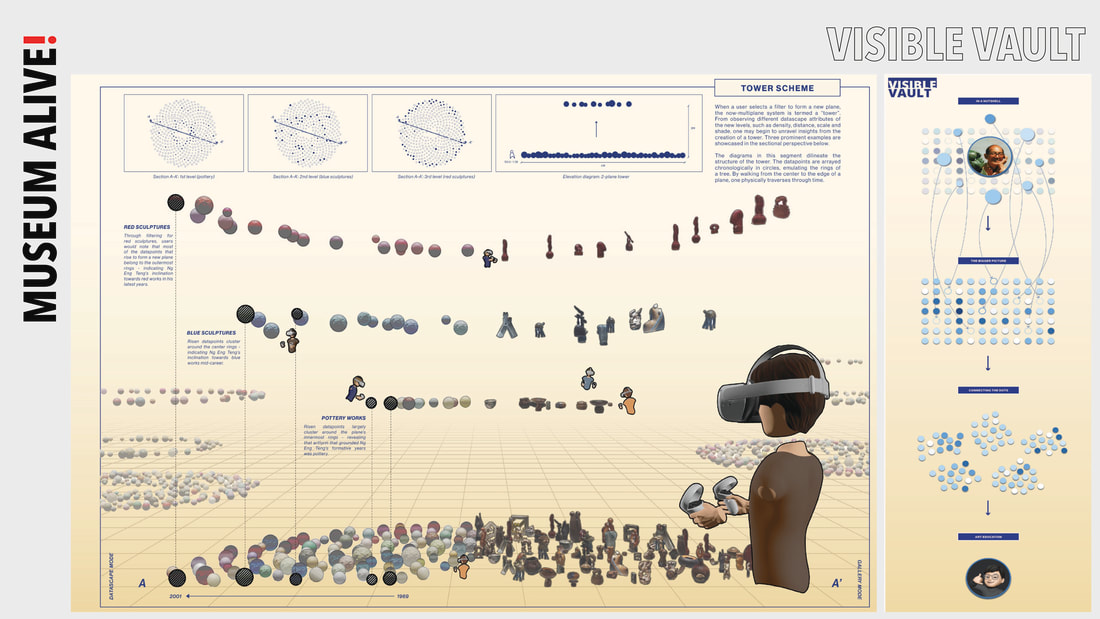Preamble
Museums around the world are working to break traditional stereotypes by revamping their designs to connect to wider groups of audiences. The emergence of virtual museums and augmented reality apps are extending the boundaries of museums beyond their physical walls. In this joint studio, architecture students will collaborate with engineering and industrial design students in designing immersive and interactive museum experiences that address a cause. Topics such as storytelling, virtual, augmented and mixed reality, embodied interaction and haptics, cultural computing and place-making will be introduced to support students in delivering diverse outcomes. Students may design interactive experiences that transform space, create new content and interaction modality, or learn a new language of technology based on three broad museum futures- The Metaverse Museum, The Inclusive Museum and the Distributed Museum.
Design Research Project
In 1947, André Malraux proposed a radical vision of a museum without walls. He imagined photography would herald a future museum experience that is distributed, accessible, and able to tell the story of artefacts from different parts of the world. Malraux believed photography’s portability and reproducibility can help overcome the limitation and physicality of a museum’s location and collection.
The emergence of immersive platforms and digital devices is not unlike the rise of photography during Malraux’s time. Their adoption for work, study, play, and recreation is inevitable and has hastened during the Covid-19 pandemic. Museums are not immune to this accelerated adoption. The global pandemic lockdowns and uncertain safe management measures have witnessed the hurried design of virtual exhibitions to address plummeting numbers of visitors and maintain the museum’s relevance during the pandemic. Artists and performers, too, recognised the reach and power of being able to show their crafts virtually while in the safety of their homes.
One stand-out example of using digital and immersive technologies for a cause is the project by art historian Wu Hung, the Harrie A. Vanderstappen Distinguished Service Professor of Art History, and the College and Consulting Curator of the Smart Museum of Art at the University of Chicago. Professor Hung strived to make whole the Buddhist sculptures that were forcefully removed from their caves and sold to private collectors and museums worldwide. The limps of the Buddhist sculptures are often cut and sold separately. Technology, in this case, has a redemptive purpose. It is a medium to recover and reconstruct the damaged Buddhist cave sculptures in China caused by violent acts of destruction and desecration. See https://www.youtube.com/watch?v=EnPEJ9xJkiE
The joint studio is driven by the following two broad challenges:
1. How do we re-imagine the role and purpose of a museum in the twenty-first century?
2. How can immersive technologies become a positive and enabling medium to engender an engaging experience within and outside the museum settings?
Research Method and Programme Details
Working in teams, the students will take part in a series of structured workshops during the first three weeks to learn and be skilled up in collaboration skills, Unity, Oculus Quest 2, Hive Vive Pro 2, Lucid glove and Infinity glove. Three categories of museum futures will provide the framework for the team’s research and design.
The Metaverse Museum: The Metaverse has garnered a lot of attention recently. It is perceived to be the new frontier where our digital selves will live, learn, work, play and be entertained. Covid-19 pandemic has also hastened efforts to develop alternative platforms and spaces to sustain our everyday lives interrupted by the pandemic. The potentials of the Metaverse and digitalisation will open up new, untapped opportunities and challenge our conventional understanding and design of museums.
How will the museum design, collections and experience be radically transformed when conceived as a Metaverse?
The Inclusive Museum: Museums are primarily designed for the sighted and the able-bodied. However, the World Bank estimated that as many as one billion people are facing disability of some kind. For a truly inclusive museum of the future, architects and designers will need to reimagine how can a collection and the spaces be designed with inclusivity in mind.
What is the role of digital and immersive technologies as enablers for the future of an inclusive museum?
The Distributed Museum: Major museums like the Guggenheim and the Louvre have franchised their brands, and distributed their collections in their star architect-designed outposts such as Abdu Dhabi. Rethinking a distributed museum experience need not be limited to spectacular museums with brand power, financial means and vast collections. Bringing the museum experience to public spaces, parks, housing estates, etc. is one meaningful form of distribution.
How can the adoption of digital and immersive technologies enable a museum to broaden its reach while being contextual in presenting its collections?
Museums around the world are working to break traditional stereotypes by revamping their designs to connect to wider groups of audiences. The emergence of virtual museums and augmented reality apps are extending the boundaries of museums beyond their physical walls. In this joint studio, architecture students will collaborate with engineering and industrial design students in designing immersive and interactive museum experiences that address a cause. Topics such as storytelling, virtual, augmented and mixed reality, embodied interaction and haptics, cultural computing and place-making will be introduced to support students in delivering diverse outcomes. Students may design interactive experiences that transform space, create new content and interaction modality, or learn a new language of technology based on three broad museum futures- The Metaverse Museum, The Inclusive Museum and the Distributed Museum.
Design Research Project
In 1947, André Malraux proposed a radical vision of a museum without walls. He imagined photography would herald a future museum experience that is distributed, accessible, and able to tell the story of artefacts from different parts of the world. Malraux believed photography’s portability and reproducibility can help overcome the limitation and physicality of a museum’s location and collection.
The emergence of immersive platforms and digital devices is not unlike the rise of photography during Malraux’s time. Their adoption for work, study, play, and recreation is inevitable and has hastened during the Covid-19 pandemic. Museums are not immune to this accelerated adoption. The global pandemic lockdowns and uncertain safe management measures have witnessed the hurried design of virtual exhibitions to address plummeting numbers of visitors and maintain the museum’s relevance during the pandemic. Artists and performers, too, recognised the reach and power of being able to show their crafts virtually while in the safety of their homes.
One stand-out example of using digital and immersive technologies for a cause is the project by art historian Wu Hung, the Harrie A. Vanderstappen Distinguished Service Professor of Art History, and the College and Consulting Curator of the Smart Museum of Art at the University of Chicago. Professor Hung strived to make whole the Buddhist sculptures that were forcefully removed from their caves and sold to private collectors and museums worldwide. The limps of the Buddhist sculptures are often cut and sold separately. Technology, in this case, has a redemptive purpose. It is a medium to recover and reconstruct the damaged Buddhist cave sculptures in China caused by violent acts of destruction and desecration. See https://www.youtube.com/watch?v=EnPEJ9xJkiE
The joint studio is driven by the following two broad challenges:
1. How do we re-imagine the role and purpose of a museum in the twenty-first century?
2. How can immersive technologies become a positive and enabling medium to engender an engaging experience within and outside the museum settings?
Research Method and Programme Details
Working in teams, the students will take part in a series of structured workshops during the first three weeks to learn and be skilled up in collaboration skills, Unity, Oculus Quest 2, Hive Vive Pro 2, Lucid glove and Infinity glove. Three categories of museum futures will provide the framework for the team’s research and design.
The Metaverse Museum: The Metaverse has garnered a lot of attention recently. It is perceived to be the new frontier where our digital selves will live, learn, work, play and be entertained. Covid-19 pandemic has also hastened efforts to develop alternative platforms and spaces to sustain our everyday lives interrupted by the pandemic. The potentials of the Metaverse and digitalisation will open up new, untapped opportunities and challenge our conventional understanding and design of museums.
How will the museum design, collections and experience be radically transformed when conceived as a Metaverse?
The Inclusive Museum: Museums are primarily designed for the sighted and the able-bodied. However, the World Bank estimated that as many as one billion people are facing disability of some kind. For a truly inclusive museum of the future, architects and designers will need to reimagine how can a collection and the spaces be designed with inclusivity in mind.
What is the role of digital and immersive technologies as enablers for the future of an inclusive museum?
The Distributed Museum: Major museums like the Guggenheim and the Louvre have franchised their brands, and distributed their collections in their star architect-designed outposts such as Abdu Dhabi. Rethinking a distributed museum experience need not be limited to spectacular museums with brand power, financial means and vast collections. Bringing the museum experience to public spaces, parks, housing estates, etc. is one meaningful form of distribution.
How can the adoption of digital and immersive technologies enable a museum to broaden its reach while being contextual in presenting its collections?










